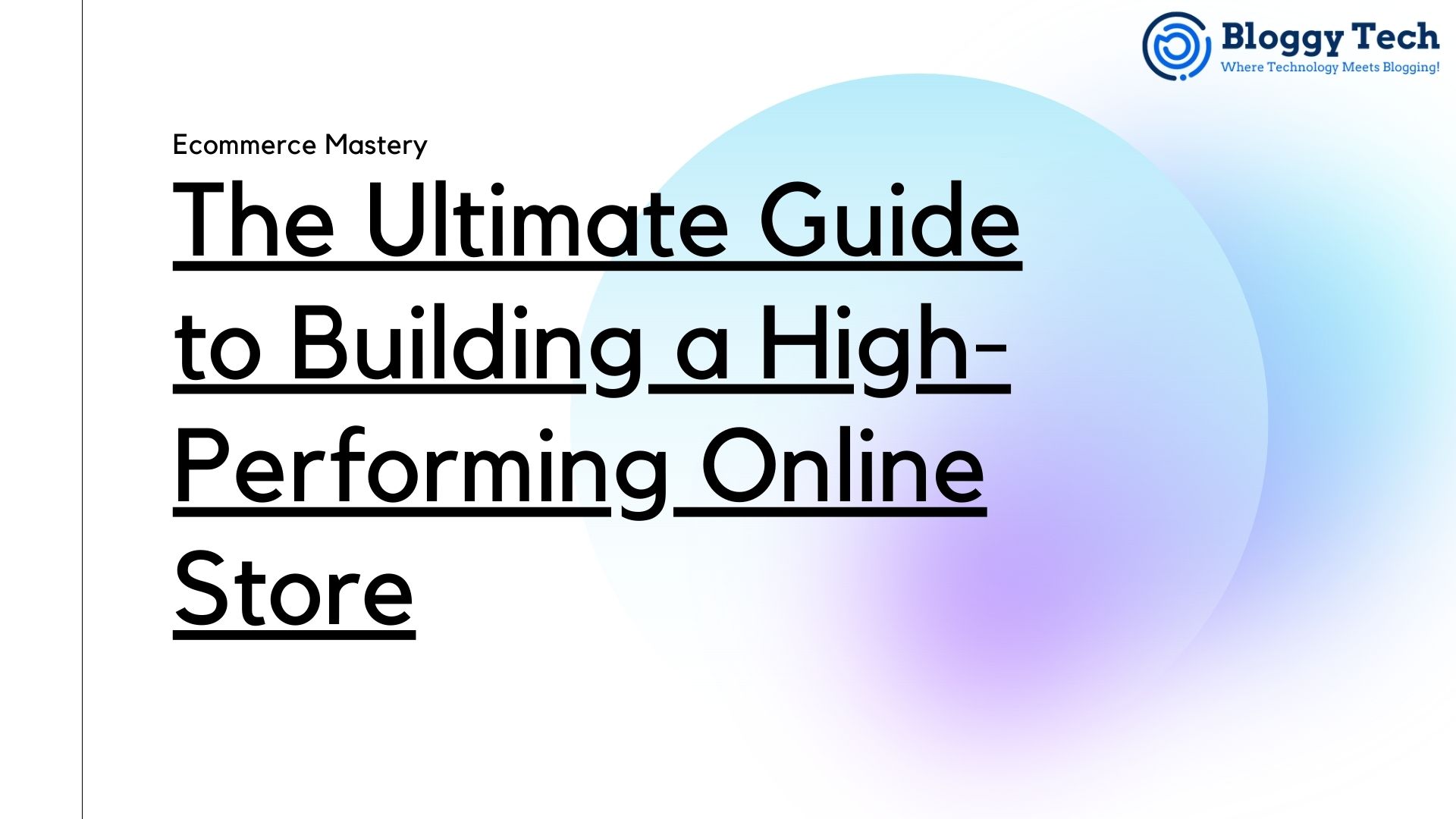Unlock your online potential with UnikBrushes - Your one-stop-shop for expert web development and digital marketing solutions.
Join BloggyTech now and stay ahead in the game with valuable insights and tips on technology, digital marketing, and personal development!
Looking for a list of trendy AI tools that can enhance and save time in your work? Check out ZynoSItes - I'm sure you'll be amazed!
Upgrade your writing game with ZynoInk - the ultimate AI-powered writing tool for students and marketing professionals. Try it now and experience the difference!
I. Introduction
Welcome to our guide on “Ecommerce Mastery: The Ultimate Guide to Building a High-Performing Online Store“! In today’s digital age, having a strong online presence is crucial for businesses of all sizes. A well-designed and user-friendly ecommerce website can increase sales, customer retention, and brand recognition. However, building a high-performing online store can be a daunting task, which is why we’ve created this comprehensive guide to help you navigate the process.
A. Explanation of the importance of building a high-performing online store
- In today’s digital age, ecommerce is a must-have for businesses of all sizes.
- Having a well-designed and user-friendly ecommerce website can increase sales, customer retention, and brand recognition.
- A high-performing online store can help you stand out from the competition and attract more customers.
- According to a recent study, the global ecommerce sales are expected to reach $4 trillion by 2020, and it’s more important than ever for businesses to have a strong online presence.
B. Brief overview of the topics covered in the guide
In this guide, we will cover the following topics:
- Planning and Research: Learn how to identify your target market, conduct competitor research, and define your unique value proposition.
- Design and Usability: Discover the importance of web design for ecommerce, best practices for user experience design, and how to choose the right ecommerce platform.
- Product and Content: Learn how to create product listings that sell, optimize product images and videos, and write effective product descriptions.
- Marketing and Advertising: Learn how to use SEO to increase visibility, the importance of social media for ecommerce, and best practices for email marketing.
- Payment and Shipping: Learn how to choose the right payment gateway, how to set up shipping options, and best practices for handling returns and refunds.
- Optimization and Analytics: Learn how to use analytics to track performance, best practices for A/B testing, and how to use customer feedback to improve the store.
- Conclusion: Recap of the key takeaways, encouragement to implement the strategies discussed, and additional resources for further learning.
We hope that this guide will be helpful in building a high-performing online store for your business. Let’s get started!
II. Planning and Research

Before building a high-performing online store, it’s important to conduct thorough planning and research. In this section, we will cover the following topics:
A. Identifying your target market
- Understanding your target market is crucial for building a successful ecommerce website.
- Use tools such as Google Analytics, Google Trends and Facebook Audience Insights to analyze your existing customer data, and identify demographics, interests, and behaviors.
- Create buyer personas to represent your ideal customer. This will help you understand their needs and tailor your marketing and product offerings accordingly.
B. Conducting competitor research
- Conducting competitor research will help you understand the market and identify opportunities to differentiate your business.
- Analyze your competitors’ websites, social media presence, and marketing strategies.
- Look at their strengths and weaknesses, and identify gaps in their offerings that you can capitalize on.
C. Defining your unique value proposition
- A unique value proposition (UVP) is a statement that clearly communicates the unique benefit a customer will receive from using your product or service.
- Your UVP should set you apart from your competition and clearly communicate the benefit of choosing your business over others.
- Your UVP should be clear, concise, and communicated prominently on your website.
In summary, Planning and research is important to understand your target market, identify opportunities and set your business apart from the competition by defining your unique value proposition. By understanding your target market and competitors you’ll be able to create a strategy that’s tailored to your specific business needs and goals. This will help you create a high-performing online store that truly resonates with your customers.
III. Design and Usability

Design and usability are crucial elements of building a high-performing online store. In this section, we will cover the following topics:
A. The importance of web design for ecommerce
- A well-designed website can increase sales, customer retention, and brand recognition.
- Aesthetically pleasing design can improve the user experience and make customers more likely to stay on the website and make a purchase.
- The design should be consistent with your brand and convey a professional image.
B. Best practices for user experience design
- User experience (UX) design is the process of designing products, services, and environments to make them usable, accessible, and desirable.
- Best practices for UX design in ecommerce include:
- Navigation should be easy to use and understand.
- Loading times should be fast.
- The layout should be clean and uncluttered.
- The website should be mobile-friendly.
- It should be easy for customers to find what they are looking for.
- The checkout process should be simple and secure.
C. How to choose the right ecommerce platform
- Choosing the right ecommerce platform is crucial for the success of your online store.
- Factors to consider when choosing a platform include:
- Budget
- Scalability
- Features and integrations
- SEO and marketing capabilities
- Payment and shipping options
- User-friendliness and ease of use
- Popular ecommerce platforms include Shopify, Magento, BigCommerce, and WooCommerce.
In summary, Design and usability are key elements to build a high-performing online store. A well-designed website can increase sales, customer retention, and brand recognition. The design should be consistent with your brand and convey a professional image. A great user experience (UX) design can improve the user experience and make customers more likely to stay on the website and make a purchase. It’s also crucial to choose the right ecommerce platform that fits your budget, scalability, features and integrations, SEO and marketing capabilities, payment and shipping options, and user-friendliness and ease of use.
IV. Product and Content

Product and content are essential to building a high-performing online store. In this section, we will cover the following topics:
A. Creating product listings that sell
- Product listings are the first thing customers see when they visit your website, so it’s important that they are well-designed and optimized for conversions.
- Tips for creating product listings that sell include:
- Use high-quality product images.
- Use clear and concise product titles.
- Use bullet points to highlight key features.
- Include customer reviews and ratings.
- Use a clear and prominent call to action.
B. Optimizing product images and videos
- Optimizing product images and videos can help increase conversions and sales.
- Tips for optimizing product images and videos include:
- Use high-resolution images.
- Use images that are well-lit and in focus.
- Use multiple images to show different angles and details of the product.
- Use videos to demonstrate how the product works or how to use it.
- Optimize images and videos for SEO by using relevant file names and alt tags.
C. How to write effective product descriptions
- Product descriptions are an important part of the sales process and can help increase conversions.
- Tips for writing effective product descriptions include:
- Use clear and concise language.
- Use keywords for SEO.
- Highlight the key features and benefits of the product.
- Use customer reviews and ratings.
- Use a clear and prominent call to action.
In summary, Product and content are essential to building a high-performing online store. Creating product listings that sell, Optimizing product images and videos, and writing effective product descriptions are crucial for increasing conversions and sales. Use high-quality images, clear and concise language, and keywords for SEO to make your product listings stand out. Use videos to demonstrate how the product works or how to use it. Highlight the key features and benefits of the product. Use customer reviews and ratings and a clear and prominent call to action.
VI. Payment and Shipping

Payment and shipping are critical components of building a high-performing online store. In this section, we will cover the following topics:
A. How to choose the right payment gateway
- Choosing the right payment gateway can help increase conversions and reduce customer friction.
- Tips for choosing the right payment gateway include:
- Consider the payment methods offered (credit card, PayPal, etc.)
- Check the fees and rates charged by the payment gateway.
- Consider the security and fraud protection offered by the payment gateway.
- Consider the customer experience, such as the number of steps required to complete a purchase.
- Look for a payment gateway that is compatible with your e-commerce platform.
B. How to set up shipping options
- Setting up shipping options can help increase conversions and improve customer satisfaction.
- Tips for setting up shipping options include:
- Offer a variety of shipping options (overnight, 2-day, standard, etc.)
- Provide accurate shipping rates based on weight and destination.
- Use a shipping calculator to provide customers with real-time shipping rates.
- Allow customers to track their orders.
- Consider offering free shipping for orders over a certain amount.
C. Best practices for handling returns and refunds
- Handling returns and refunds can help increase customer satisfaction and reduce customer churn.
- Tips for handling returns and refunds include:
- Have a clear and easy-to-find returns policy on your website.
- Make the returns process as easy as possible for customers.
- Offer refunds or exchanges for items that are returned.
- Respond to customer inquiries about returns and refunds in a timely manner.
- Use a returns management software to automate the process.
In summary, Payment and shipping are critical components of building a high-performing online store. Choosing the right payment gateway, setting up shipping options, and handling returns and refunds are all important for increasing conversions and improving customer satisfaction. Consider the payment methods offered, fees and rates charged, security and fraud protection and customer experience offered by the payment gateway. Offer a variety of shipping options and provide accurate shipping rates. Use a shipping calculator to provide customers with real-time shipping rates. Allow customers to track their orders. Consider offering free shipping for orders over a certain amount. Have a clear and easy-to-find returns policy on your website and make the returns process as easy as possible for customers. Respond to customer inquiries about returns and refunds in a timely manner. Use a returns management software to automate the process.
VII. Optimization and Analytics

Optimization and analytics are key to building a high-performing online store. In this section, we will cover the following topics:
A. How to use analytics to track performance
- Analytics can provide valuable insights into how your online store is performing and help identify areas for improvement.
- Tips for using analytics to track performance include:
- Set up Google Analytics to track website traffic and user behavior.
- Use data visualization tools to make sense of the data.
- Track key metrics such as website traffic, bounce rate, conversion rate, and revenue.
- Use heat maps to understand user behavior on your website.
- Use A/B testing to determine what changes to your website will lead to the best results.
B. Best practices for A/B testing
- A/B testing is a powerful way to optimize your website and improve conversions.
- Tips for A/B testing include:
- Test one element at a time (such as a button color or headline).
- Use a large sample size to get statistically significant results.
- Use a tool such as Optimizely or Google Optimize to set up your tests.
- Analyze the results of your tests to determine what changes led to the best results.
C. How to use customer feedback to improve the store
- Customer feedback can provide valuable insights into how to improve your online store.
- Tips for using customer feedback to improve the store include:
- Collect feedback through surveys, reviews, or customer support interactions.
- Use feedback to identify areas for improvement.
- Prioritize feedback based on impact and feasibility.
- Use feedback to inform A/B testing and other optimization efforts.
- Use feedback to improve the customer experience.
In summary, Optimization and analytics are key to building a high-performing online store. Use analytics to track performance, set up Google Analytics to track website traffic and user behavior, use data visualization tools to make sense of the data, track key metrics such as website traffic, bounce rate, conversion rate, and revenue, use heat maps to understand user behavior on your website, use A/B testing to determine what changes to your website will lead to the best results. A/B testing is a powerful way to optimize your website and improve conversions. Test one element at a time, use a large sample size to get statistically significant results, use a tool such as Optimizely or Google Optimize to set up your tests, analyze the results of your tests to determine what changes led to the best results. Use customer feedback to improve the store, collect feedback through surveys, reviews, or customer support interactions, use feedback to identify areas for improvement, prioritize feedback based on impact and feasibility, use feedback to inform A/B testing and other optimization efforts, use feedback to improve the customer experience.
VIII. Conclusion
In this guide, we have covered the key steps and strategies for building a high-performing online store. In this final section, we will summarize the key takeaways and provide additional resources for further learning.
A. Recap of the key takeaways:
- Identifying your target market and conducting competitor research are crucial for building a successful online store.
- A well-designed website with a great user experience is essential for online store success.
- Optimizing product listings, images, and descriptions can improve conversions.
- Choosing the right payment gateway and shipping options is important for customer satisfaction.
- Analytics and A/B testing can be used to optimize the online store and improve performance.
- Customer feedback can be used to identify areas for improvement.
B. Encouragement to implement the strategies discussed:
- Building a successful online store takes time and effort, but by following the strategies outlined in this guide, you will be well on your way to creating a high-performing ecommerce site.
- Remember to stay focused on your target market, stay up to date on industry trends and best practices, and continuously iterate and improve your online store.
C. Additional resources for further learning:
- The Shopify ecommerce blog offers a wealth of information on building and optimizing an online store.
- EcommerceFuel is a community and resource for ecommerce entrepreneurs.
- Ecommerce Mastery by Neil Patel is a great resource for learning more about building a high-performing online store.
- The book “Conversion Rate Optimization: The Definitive Guide” by Brian Massey provides a thorough overview of conversion rate optimization best practices.
In summary, Building a high-performing online store takes time and effort, but by following the strategies outlined in this guide, you will be well on your way to creating a successful ecommerce site. Remember to stay focused on your target market, stay up to date on industry trends and best practices, and continuously iterate and improve your online store. The Shopify ecommerce blog, EcommerceFuel, Ecommerce Mastery by Neil Patel, and the book “Conversion Rate Optimization: The Definitive Guide” are great resources for learning more about building a high-performing online store.
Thank you for coming this far, I hope you have a prosperous and wonderful day ahead 🙂👍
Looking for a ecommerce developer who can make your store live in the digital world with ease? Then consider checking out my Brand.
Regards,
Amar
Any doubts? Contact me
Unlock your online potential with UnikBrushes - Your one-stop-shop for expert web development and digital marketing solutions.
Join BloggyTech now and stay ahead in the game with valuable insights and tips on technology, digital marketing, and personal development!
Looking for a list of trendy AI tools that can enhance and save time in your work? Check out ZynoSItes - I'm sure you'll be amazed!
Upgrade your writing game with ZynoInk - the ultimate AI-powered writing tool for students and marketing professionals. Try it now and experience the difference!
Best Regards,
Amar



